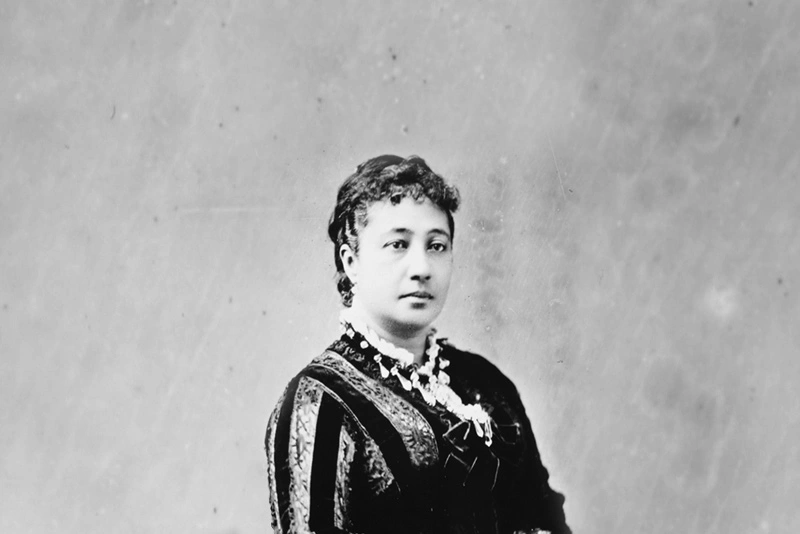January 25 marks the 200th anniversary of the birth of Charles Reed Bishop, husband of Ke Ali‘i Bernice Pauahi Bishop, and the driving force in the creation of the Kamehameha Schools.
At the sacred burial place of our aliʻi, Maunaʻala, a stone monument to Charles Reed Bishop is inscribed “Builder of the State – Friend of Youth – Benefactor of Hawai‘i.” In honor of his life and legacy of service to ka lāhui Hawaiʻi, we share more about this man who loved Hawaiʻi.
Bishop was born on Jan. 25, 1822, in Glens Falls, New York. He traveled to Hawaiʻi as a young man, landing in Honolulu in October 1846 when treacherous waters forced the ship he was a passenger on to make a detour to the islands. The decision to stay in the islands would be pivotal for both Bishop and the kingdom.
A bright and industrious young man, Charles quickly became known and welcomed in Honolulu. In 1849, three years after arriving, he became a citizen of the Hawaiian Kingdom and was appointed its collector of customs. He decided to remain in Hawaiʻi after he met and fell in love with Princess Bernice Pauahi Pākī, great-granddaughter of Kamehameha I.
Bishop and Pauahi married in a small ceremony on June 4, 1850. Pauahi had been betrothed at birth to Prince Lot Kapuāiwa, but seeing her love for Bishop, Kapuāiwa released their agreement and gave his blessing to the marriage. Pauahi’s parents aliʻi nui Abner Pākī and Laura Konia, as well as her adoptive parents Elizabeth Kīnaʻu and Mataio Kekūanāoʻa overcame their initial objections to the marriage when Bishop proved to have the interests of their beloved princess and the Kamehameha family at heart.
The aliʻi came to rely on Bishop, and he served in a variety of important positions for five Hawaiian monarchs from 1859–1891; including Privy Council member, foreign minister, and president of the Board of Education. In 1876, King Kalākaua appointed Bishop to Ho‘oulu Lāhui, a committee dedicated to halting the decline of the Hawaiian race.
The Bishops were a power couple in the kingdom, dedicating their lives to philanthropy in healthcare and education. Over the years, they supported many health organizations including the Queen’s Hospital, Kapiʻolani Maternity Home, Lē‘ahi Hospital, Kauikeolani Children’s Center, and the Salvation Army.
Ke Ali‘i Pauahi died on Oc. 31, 1884. Bishop worked for the rest of his life to continue their work. As one of five trustees of her estate, Bishop set in motion the establishment of Kamehameha Schools. He contributed his own funds for the construction of the schools’ first buildings and returned all the lands that she had left him in her will to her estate, adding much of his personal lands as well. He also initiated and funded the establishment of the preparatory school at Kamehameha.
Bishop supported many other educational institutions, helping to shape the future of education in Hawai‘i. The schools included Oʻahu College (now Punahou School), Kawaiahaʻo Seminary and the Mills Institute (now Mid-Pacific Institute), St. Andrew’s Schools, and Sacred Hearts Academy.
At the time of his wife’s passing, the Royal Mausoleum at Mauna‘ala was crowded with caskets. Bishop built an underground vault for Pauahi and more than 20 members of her royal ‘ohana. The family was ceremoniously interred there together in 1887.
In 1889, Bishop founded the Bernice Pauahi Bishop Museum as an enduring memorial to his wife to safekeep the mea makamae — treasured heirlooms — of the Kamehameha family. Bishop hoped the museum would serve as a place where Kamehameha haumāna could learn and draw pride from their cultural heritage. Today, Bishop Museum continues to steward these treasured heirlooms, along with many other unique and irreplaceable collections and objects that honor and perpetuate Hawai‘i’s cultural and natural history as a nonprofit 501(c)3 entity.
A benevolent man, Bishop established the Charles Reed Bishop Trust in 1895 to support causes that had been important to him and Ke Ali‘i Pauahi. Today, the beneficiaries of the trust include: Bernice Pauahi Bishop Museum, Central Union Church, Kaumakapili Church, Kawaiaha‘o Church, Kamehameha Schools, Mid-Pacific Institute and Lunalilo Trust. And to this day, Bishop’s trust continues to provide for the upkeep of Maunaʻala.
Charles Reed Bishop passed away in Berkeley, California on June 7, 1915 at the age of 93. When news of his passing reached the islands, flags were flown at half-staff. His ashes were returned to Hawai‘i and a kāhili service held in his honor at Kawaiaha‘o Church. A testament to the aloha the aliʻi felt for Bishop, this was the first time such a service was held for a white man since the death of John Young, trusted advisor to Kamehameha I. A procession to Mauna‘ala followed. His ashes were placed in the vault of the Kamehameha family.
Hawaiʻi remains indebted to Charles Reed Bishop’s legacy of love for Pauahi and the Hawaiian people. History illuminates him as a man of integrity who through his noble actions had gained the aloha of our aliʻi and the Hawaiian people.
TAGS
charles reed bishop,founder's day,200th anniversary
CATEGORIES
Kaipuolono Article, Regions, Themes, Culture, Community, Leadership, Employee ‘Ohana, Ka ʻohana Kamehameha, Hawaii Newsroom, KS Hawaii Home, I Mua Kamehameha, Kapalama Newsroom, Kapalama Home, Maui Newsroom, KS Maui Home, Newsroom, Campus Programs, Hawaii, Kapalama, Maui, Community Education, Department News, Features, Oiwi Leaders, Hawaii campus, Kapalama campus, Maui campus
Print with photos
Print text only










